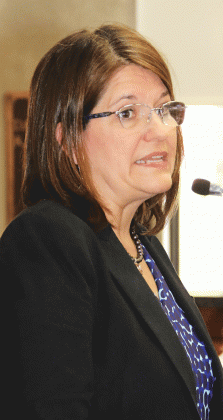
Harlan Kirgan
Before flooding problems are alleviated in South Louisiana, there is a need to understand the watersheds said Monique Boulet, CEO of the Acadiana Planning Commission.
“We need more information. We need more data and that’s where the gauge project comes in,” she said at Wednesday’s meeting of the St. Landry Parish Council.
“We are pursuing a model for the entire region,” she said. “It is not just St. Landry Parish, it is across the region, actually across the entire state,” she said.
In February a $2.4 million project to install water gauges across the parishes of Acadia, Evangeline, Iberia, Lafayette, St. Landry, St. Martin, St. Mary and Vermilion was announced.
Some 230 gauges will be placed in waterways across the eight parishes to measure rain and flow.
Boulet spoke about that plan at the Parish Council’s March meeting and returned at Wednesday’s meeting to continue a discussion about drainage issues.
Developing information across the region will help in obtaining funding for projects, she said.
“Nobody has the science in place to understand the system-wide implications,” Boulet said.
Councilman Jerry Red said flooding problems are evident in drainages, particularly in western St. Landry Parish, that are clogged with debris, trees and other obstructions.
Boulet said, “I’m going to try to say this very tactfully. I don’t know that the state is ever going to get to the local level drainage level because there are so many problems across the entire state.”
The state has about $9 million budgeted for drainage statewide, she said.
If there is no funding to clear brush, trees and other debris there will always be flooding problems, Red said
Councilman Timmy Lejeune said main canals were were once managed by the federal government were transferred to the state and eventually to the local level.
“To implement a tax that would even come close to spraying the canals is unheard of simply because there is nothing to support it,” Lejeune said.
“You talking to one of the poorest parishes in the sate, so it is really a crying shame that we are put in a class of people on finances like Lafayette Parish or another parish because they can generate $20 million revenue and say they may be entitled to even more funding than we would be because of lack of revenue source,” Lejeune said.
Bayou Mallet was dredged sometime around 1960 “and has never been touched since,” he said.
Lafayette and St. Martin parishes have parish taxes to support drainage work.
Lejeune said the federal government is going to have to help.
“I’m telling you probably a 100-mill property tax wouldn’t even come close” to satisfying drainage issues in his district, which is east of Eunice to Lawtell and includes the Bayou Mallet drainage.
Parish President Bill Fontenot, who is chairman of the Acadiana Planning Commission, said St. Martin Parish disbanded its local drainage districts to fund a parish effort. Recently, the parish embarked on a $25 million drainage project.
St. Landry Parish has 13 drainage districts.
Fontenot said a model for the watersheds, which are the Teche, Vermilion and Mermanteau in the commission’s area, would help avoid the problem of drainage work in one area harming another area.
A model would show what can be done without adversely affecting a neighboring parish, he said.
